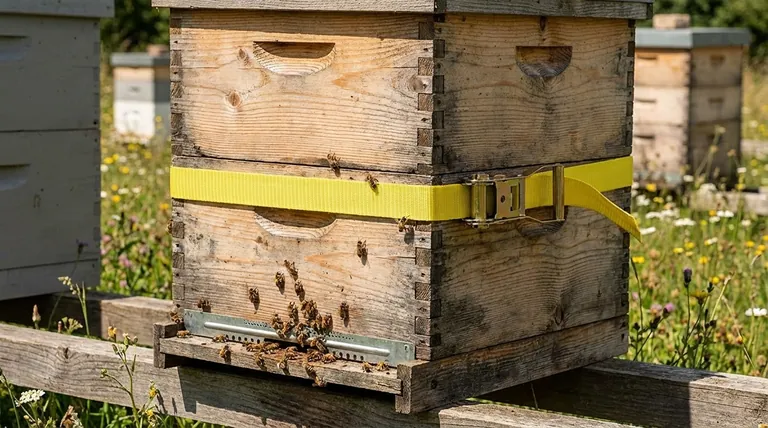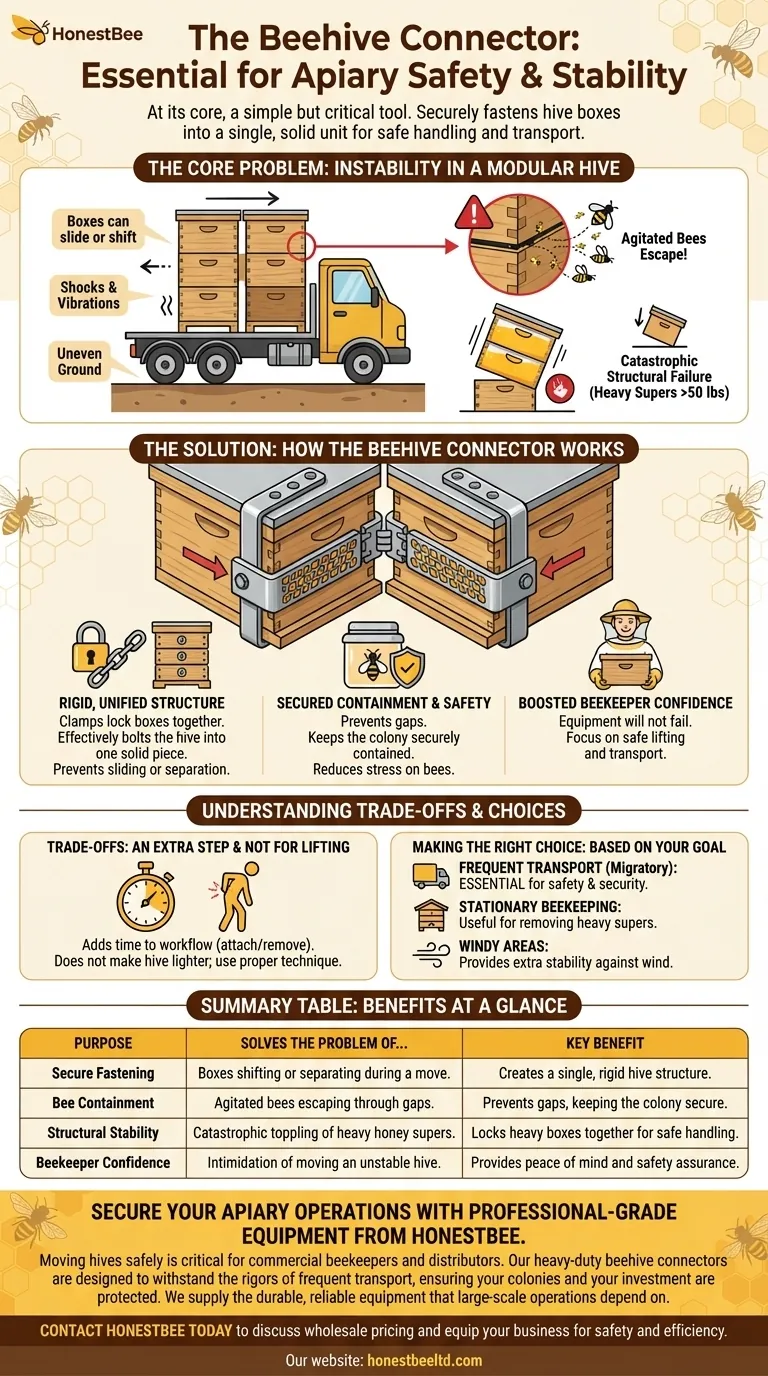At its core, the beehive connector is a simple but critical tool for safety and stability. Its primary purpose is to securely fasten the separate boxes (or "extensions") of a beehive together, creating a single, solid unit that is safe to handle and move.
The fundamental challenge of beekeeping is managing a modular system of heavy, bee-filled boxes. The beehive connector solves the critical problem of hive instability during transport, preventing boxes from shifting, falling, or leaking agitated bees.

The Core Problem: Instability in a Modular Hive
A modern beehive is not a single box but a stack of components: a bottom board, one or more brood boxes, honey supers, an inner cover, and a lid. This modularity is essential for management, but it creates an inherent weakness.
The Inherent Risk of Stacked Boxes
Each box simply rests on the one below it. While gravity works well for a stationary hive, this design becomes a liability the moment you need to move it.
The boxes can easily slide or shift, especially on uneven ground or during the bumps and vibrations of vehicle transport.
The Consequences of a Shift
Even a small shift can create a gap between boxes. This can lead to two major problems: agitated bees escaping the hive and a catastrophic structural failure where heavy boxes topple over.
This risk is magnified when handling honey supers, which can weigh over 50 pounds (23 kg) when full, making the entire stack top-heavy and difficult to manage.
How the Beehive Connector Provides a Solution
The connector acts as a locking mechanism, transforming a precarious stack into a secure, unified block. It directly addresses the core risks of moving a hive.
Creating a Rigid, Unified Structure
The connector clamps onto the edges of two adjacent hive boxes, physically locking them together. By placing connectors on opposite sides, you effectively bolt the hive into a single piece.
This rigidity ensures that no matter how the hive is lifted or jostled, the boxes cannot slide or separate from one another.
Ensuring Safety and Containment
By preventing gaps from forming, the connector keeps the colony securely contained. This is vital for the safety of the beekeeper and anyone nearby, and it significantly reduces stress on the bees during a move.
Boosting Confidence for the Beekeeper
Lifting and moving a heavy, buzzing stack of boxes can be intimidating. A securely connected hive gives the beekeeper confidence that the equipment will not fail, allowing them to focus on safe lifting and transport.
Understanding the Trade-offs
While highly effective, beehive connectors are another piece of equipment to manage and are not a substitute for proper technique.
An Extra Step in Hive Management
Using connectors adds a small amount of time to your workflow. You must attach them before moving a hive and remove them before performing an inspection that requires separating the boxes.
Not a Replacement for Proper Lifting
Connectors secure the hive components to each other, but they do not make the hive any lighter. You must still use proper lifting techniques or get assistance to move a heavy colony to avoid back injury.
Making the Right Choice for Your Goal
Whether you need beehive connectors depends entirely on how you manage your colonies.
- If your primary focus is moving hives frequently: These are essential tools that provide an invaluable layer of safety and security during transport.
- If your primary focus is stationary beekeeping: They are less critical but can be very useful for the seasonal task of removing heavy, full honey supers.
- If you are a hobbyist with hives in a windy area: Connectors can provide extra stability to prevent lids or even entire hives from being blown over.
Ultimately, using beehive connectors is a simple measure to ensure the safety of your bees and your own peace of mind.
Summary Table:
| Purpose | Solves The Problem Of... | Key Benefit |
|---|---|---|
| Secure Fastening | Boxes shifting or separating during a move. | Creates a single, rigid hive structure. |
| Bee Containment | Agitated bees escaping through gaps. | Prevents gaps, keeping the colony secure. |
| Structural Stability | Catastrophic toppling of heavy honey supers. | Locks heavy boxes together for safe handling. |
| Beekeeper Confidence | Intimidation of moving an unstable hive. | Provides peace of mind and safety assurance. |
Secure your apiary operations with professional-grade equipment from HONESTBEE.
Moving hives safely is critical for commercial beekeepers and distributors. Our heavy-duty beehive connectors are designed to withstand the rigors of frequent transport, ensuring your colonies and your investment are protected.
We supply the durable, reliable equipment that large-scale operations depend on.
Contact HONESTBEE today to discuss wholesale pricing and equip your business for safety and efficiency.
Visual Guide

Related Products
- Endless Loop Ratchet Hive Strap
- Professional Galvanized Hive Strap with Secure Locking Buckle for Beekeeping
- Beehive Entrance Discs Plastic Bee Entrance Disc for Bee Hives
- Professional Drop-Style Hive Handles for Beekeeping
- Automatic Honey Flow Beehive 4 Frame Mini Hive for Beekeeping
People Also Ask
- How can beekeepers secure the top cover of a hive? Protect Your Colony from Wind and Weather
- Where is the best location for a bee hive? Maximize Colony Health & Honey Production
- How does climate influence the choice of hive for beekeepers? Optimize for Moisture & Temperature Control
- What are the basic components of beekeeping equipment? Build a Thriving Hive from the Start
- What is the importance of understanding the function of each part of the beehive? Master Your Hive for a Thriving Colony



















